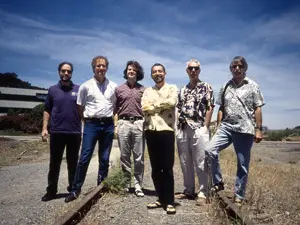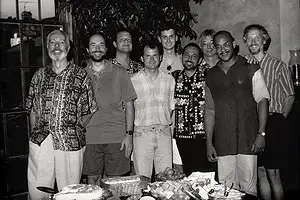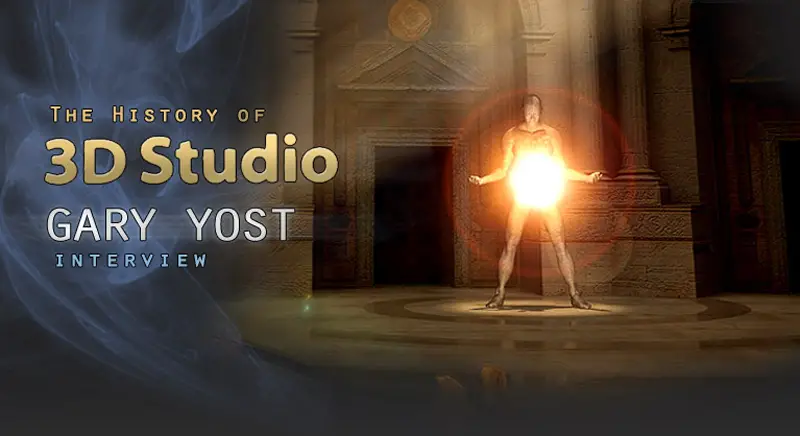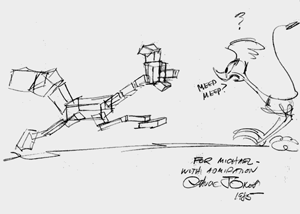– Tom mentions that the name 3D Studio was suggested by Autodesk marketing, along with other possibilities such as “Yost”. Do you recall other possible names that were considered?
Tom’s memory is correct… there was a very surreal meeting in which I had to shoot down the idea of using my own name as a brand for the Autodesk line of DCC products. The name 3D Studio came about because Tom, Jack Powell and I had previously created a package called Cyber Studio for the AtariST, which included CAD-3D as the primary component, along with some other plugins and 3D clip art. 3D Studio is just a concatenation of the second parts of CAD-3D and Cyber Studio. 3D Studio!
– John Walker recommends in April 1991 to “move the product to Windows as soon as technically feasible”. When and why did you decide to embark on the development of 3D Studio MAX?
Oh boy. We had a good thing going with 3DS DOS. Lots of IPAS plugins, great enthusiastic user base and excellent sales. But there were lots of problems with that architecture and we all knew that we wouldn’t be able to keep our DOS users happy once Windows was capable of supporting large memory via 32bit addressing. The separate working modules were a huge problem, along with lack of procedural editing and totally modal IPAS plug-ins. These things drove us (and our customers) crazy by the time we got to DOSr3, and as soon as we found out from IBM that WinNT 3.1 was going to be released summer 1993 we made the decision to re-architect. The first step was hiring Don Brittain away from Wavefront, where he was chief scientist. Don was unhappy with Wavefront’s decision not to move to the PC platform and he’d been talking with me about that. In fact, Don was on the verge of accepting a job at Microsoft and moving from Santa Barbara to Seattle when I came to him in January 1993 and asked him to join our team. Of course when he found that he could work from his home instead of moving that was a great benefit, and he started working on Max prototypes in February.
1993 was a big year for 3DS/DOS too. We added hundreds of new features while Don was in the skunkworks with the Windows version. He had some pretty exciting prototypes working by the end of that year and we were all itching to move over and get working. But there were still some critical features we needed to get into the DOS version before we spent 2 years on the new platform… particularly inverse kinematics. Remember, we only had 2 developers on DOS and 1 on Max at the time… no extra resources were available. Fortunately I’d been working with Rolf Berteig on some interesting IPAS plugins (in the area of L-System plantlife) and he was such a joy to work with that I began talking to him about doing a more ambitious IPAS IK plugin. He jumped right in and that became the heart of 3DS/DOSr4 (well, maybe we should’ve called it 3.5). It was obvious that Rolf was an intrepid software engineer… he had no qualms going anywhere or doing anything. During that project we made him an offer to become a full partner and work on Max with us as soon as he was finished. Once DOSr4 shipped in mid ’94 we had four brilliant and completely unstoppable engineers to focus on Max.
Don had a very solid prototype by that time and we had written a specification for this new app that we code-named Jaguar. In September we began development in earnest, but we ran into snags. Our MIS infrastructure was very shaky… we were using dial-up 56Kbaud modems into a server at Don’s house. The code base was going to get quite large and already in the beginning we began to run into problems with dropped phonelines during source control system updates. Don was spending all of his time just trying to manage source database corruption problems during October, and by early November we were almost ready to give up. (For the want of a nail…)

A photo of the Yost Group circa 1995
The Road Runner meets Biped – a drawing by
Chuck Jones dedicated to Michael Girard after seeing his research on 3D bipeds and quadrupeds
Luckily Gus Grubba, who we’d been working with on Video Post and other aspects of 3DS/DOS and was a great friend, mentioned that a new form of data-communications called ISDN was just coming online. We all checked with our local telecoms and found that it was available for all of us just that month! It took a few weeks to get everybody up and running with ISDN but by January 1, 1995 we were flying, rock solid. Now things really started to move, and the rest is pretty much history. It only took us 6 months to bring Max up enough to show (what looked like a nearly finished product) at Siggraph LA 1995. The demo totally blew away the Microsoft/Softimage folks, who had just merged and begun work on XSI. And the people from Alias simply stood around our booth, mouth agape. That was my favorite Siggraph ever. We shipped Max in April 1996, so in all there were only about 15 months of actual development time in r1… quite a feat for 4 engineers with a completely new architecture.
How did Character Studio authors Michael Girard and Susan Amkraut join development?
Michael Girard and Susan Amkraut were an incredibly important part of all this. They had met with our product manager in very early 1995 and were then introduced to me. We showed them what we were doing and they showed us some early Biped tests. There was a lot of excitement in the room that day and we all saw how interesting it would be for Biped to prove the flexibility of our APIs. Plus of course Biped was a brand-new way of animating – something that our customers had been only dreaming about… procedural character animation. Another revelation along the path. The dancing baby animation actually first manifested as a dancing monkey in our 1995 Siggraph demo, and that totally floored the crowd. Not only had we launched a new procedural architecture, but there was Biped… a revolutionary way of animating. It was almost too much for some people.
– When and how did the name 3D Studio Max come up?
This was a tough one… we were obsoleting our DOS product with this totally new (and basically incompatible) Windows technology, but we wanted to maintain the 3D Studio brand. In a 1995 meeting with Anna Mellilo (our marketing manager at Autodesk), we were struggling with how to do this. On a break, she started talking about her young son Max. I’d been chewing on the name problem in the corner and heard her say “Max” just as I was thinking “3D Studio”. So thanks to Anna (and her son), we got our name. (Although it was ironic that Max did not run on Macs.)
– When did you come up with the concept of integrating the different 3DS modules into a unified modeling/animation environment?
We’d been looking carefully at various workstation-level 3D animation systems all the way back to the 1980s, and were especially impressed by systems from Symbolics and Side Effects. They provided a level of integration and procedural control that was just so powerful. At the same time, we wanted to create something that was easier to use. It was obvious that an integrated environment was what our customers wanted, so that was our paramount design goal.
– What key elements were taken into account when designing Max’s modifier stack? Did you think about pushing proceduralism further?

A photo from the Autodesk Max launch party during SIGGRAPH 1996, which took place in August in New Orleans. Max had been officially released a few months earlier, in April 1996.
We certainly were committed to a procedural approach, but even more important was our need to make it robust. Our biggest design goal was to make sure the stack was going to work quickly and reliably in production. That inspired things like lazy stack evaluation to make it fast by not doing anything that wasn’t necessary at the time. (One of the 8 patents that we were awarded for Max was in this area. You can google it with the search term “3ds max lazy evaluation”… it’s interesting reading and was totally novel at the time.)
The capabilities of the modifer stack improved over time – especially when the development team at Autodesk added the Stack View for r4. That was an outrageously great enhancement to the stack and I’m sure everyone is grateful for it.











